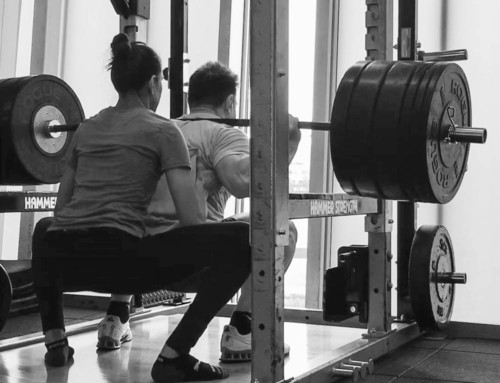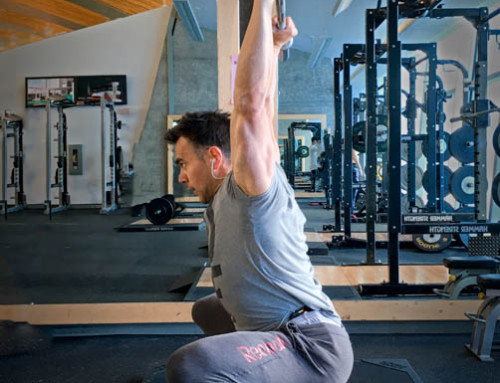There is a visible physical difference noted when comparing an average woman and man. Men tend to be taller, with broader shoulders and more muscle. Women are shorter in stature often possessing an hour glass figure. This difference in physical appearance further translates into energy pathway preferences between sexes during rest, as well as physical activity. In this article, we’ll discuss some of the physiological aspects regarding women’s and men’s physique. We will focus on gender differences in muscle fibers, fat deposits, intensity level and fatigue, and how these relate to appropriate metabolism and energy systems.
 Physical Features: Muscle Fibers
Physical Features: Muscle Fibers
Men tend to be bigger than women, and this size difference translates into muscle mass. On average, women have only two thirds the muscle mass of men. More muscle results in greater strength, allowing men to produce large amounts of force quicker than women. Having said that, both sexes have similar potential for building muscle tissue. This is possible by taking physical difference into account and comparing a woman and a man with relatively same amounts of muscle mass.
Women not only have less muscle, but also carry more fat; averaging about twice the amount compared to men. Greater body fat reserves is a physiological adaptation by storing the most compact form of energy in order to ensure survival and support of important processes within reproductive system. Females are designed for reproduction with pregnancy, fetal and newborn development stages genetically preprogrammed and translated through metabolic and anabolic (hormones) processes. This evolutionary blueprint has been shaped for hundreds to thousands of years surviving difficult times of extreme environments, predation, and food scarcity.
Muscle Fiber Distribution
Genetic material in both men and women has been shaped by history. Evolving appropriate traits including the difference in muscle mass along with fiber types in order to support and adapt to specific physiological stressors. Men evolved from hunting and protecting their tribes, as did their muscle fiber distribution. Because of specific physical and physiological demands men developed greater number of fast twitch (type II), and women larger proportion of slow twitch (type I) muscle fibers. In reference to training, this difference in muscle fiber distribution is less evident in beginners (both men and women), as untrained body requires physical stimuli in order to initiate specific adaptations towards each own potential. Through training progression, men’s muscle mass begins to develop with greater distribution of fast twitch fibers. Women also react to physical activity through increase of lean body mass containing a larger pool of slow twitch fibers.
The muscle fiber type and distribution correlates with specific abilities, as men often do better in strength and power style physical acts; while women excel in volume and endurance style training. Men can maximize their fast twitch fiber potential to lift heavy loads (strength) and/or perform exercises with speed (power), but unable to maintain such efforts for long periods of time. Women on the other hand are more than capable of lifting heavy (adjusting for body difference), as well as sustaining selected intensity longer than men. This is again due to physiological evolution of female’s greater distribution of slow fast (aka fatigue resistant) fibers, and oxidative system capable of supporting strong physical performance for extended lengths of time. In order to generate mechanical force, both men and women evolved preferences in how their systems produce energy.
Metabolic Feature: Fat, Muscle and Health
Fat and glucose metabolism varies within genders, as does selection of each substrate for storage and use, during rest and activity. Preference to different biomotor abilities – strength for men and endurance for women – is relayed through physiological adaptations of appropriate muscle fiber distribution. To fuel these activities, both male and female body utilize both substrates, but developed preference for one over the other. To support their appropriate functions, at rest women use less fat than men. This is reversed during physical exercise, as women burn more fat to resynthesize ATP when compared to men. Men’s system tends to favour glucose as substrate for energy during physical activities, while using more fat (both from food and storage) during recovery.
Fat Storage and Distribution
Physiological differences between genders translates into different body compositions between men and women. In reference to fat storage:
- Women’s greater fat deposits tend to be subcutaneous in nature, which are stored near the surface under the skin. These fat depots are often found around hip, thigh and buttocks area, and give a gynoid or pear body shape. Because women use fat during exercise, they also have greater intramuscular triglyceride (IMTG) deposits within muscle cells. This allows for fast and immediate substrate delivery to mitochondria for energy production.
- Men’s fat metabolism differs in several ways including storing large portion of triglycerides inside the body around the organs, referred to as visceral fat. Excess visceral fat is considered potentially more dangerous type of fat, with links to insulin resistance and greater risk of obesity and type 2 diabetes. Fat stored around the belly is referred to as android or apple body shape. Men utilize more glucose than fat during physical exercise through both anaerobic and aerobic pathways, and therefore have greater glycogen storage when compared to women.
Both fat and glucose metabolism are coordinated by number of hormones within their respective concentrations. These hormones stimulate/inhibit various tissues, regions, and/or other chemicals (other hormones, cytokines, and enzymes involved in such reactions such as HSL and LPL), generating required energy for either rest or active periods.
Metabolic Health
On average women’s metabolism is slower than men’s due to higher fat and lower muscle mass. However, the overall metabolic health of women is often better when compared to men. This statement may sound contradictory, but becomes more evident by looking at involved processes within muscle and fat tissue.
 Muscle is an active tissue requiring greater energy for activity and maintenance. Muscle function, recovery, growth (hypertrophy) all require tremendous amount of ATPs, a slew of hormones, enzymes, growth factors and other chemical compounds. Muscle is related to fitness and health, and for the right reasons.
Muscle is an active tissue requiring greater energy for activity and maintenance. Muscle function, recovery, growth (hypertrophy) all require tremendous amount of ATPs, a slew of hormones, enzymes, growth factors and other chemical compounds. Muscle is related to fitness and health, and for the right reasons. - Fat on the other hand is often viewed as stubborn, undesirable mass, associated with lethargy, weakness and health risks. There is some truth to this statement as excess body fat has been linked to number of cardiovascular and metabolic syndrome diseases. However, body fat is more than a simple triglyceride storage facility. It has an active metabolism generating numerous health benefits. Adipose tissue is far more active than people believe it to be, consisting of different type of cells, while having its own vascular circulation. Furthermore, adipose tissue has been designated as an endocrine organ, generating and regulating number of hormones, growth factors and enzymes. By consistently engaging in free fatty acid storage and utilization, women receive metabolic benefits associated to this endocrine response. This includes greater insulin sensitivity towards blood sugar levels, as women shuttle sugar into muscle at lower insulin concentrations more affectively than men. Switching between glucose and fat to store and produce energy also increases overall metabolic flexibility (article coming soon-please Subscribe), which is what women tend to do more of.
Training Considerations
Exercise is a factor that yields numerous health benefits for both genders. Since women use more fat during exercise and sugar at rest, physical activity is the primary method and strategy to burn fat. Men’s physiology uses greater ratio of glucose to fat during exercise, reversing substrate preference during recovery. Men burn more fat during recovery periods from resistance training sessions. Therefore, whether the goal to lose adipose tissue or just being healthy, physical exercise engages fat metabolism in both sexes, yielding greater fat loss, improved blood sugar response, while refining overall metabolic flexibility.
Should women and men train differently?
This is a good question and the answer largely depends on your definition of “different”. Common belief for men is to increase strength through resistance training, while women predominantly engage in cardiovascular exercise. This is a tunnel vision strategy that will not maximize full potential of either gender. Adjusting training to your preferred energy system, or supposed genetically specific muscle fiber disposition, is not an ideal approach in developing exercise strategy either. Such variables play a more evident role during an analysis of an on-going physical routine. However, should not be the foundation principles of your protocol.
Different training styles, versus different exercises, versus different overload variables, will all yield different results. And combination of all these “different” actions further overlaps physical stimuli generating an even more specific adaptations. As far as the training goes, studies have shown that anything men can do, women can do the same, and do it for longer periods. Even though women tend to use more fat during exercise, they also use glucose for ATP resynthesis. As men use sugar for fuel, they also use fat during and post physical bouts. Women have and utilize their appropriate distribution of fast twitch (type II) during exercise, following the size principle; and recruiting fast motor units (MUs) as exercise session goes on. Due to body differences, men are capable of greater strength and power outputs. However, women’s developed fat metabolism allows extended physical performance at relatively high intensities for longer durations.
Gender, age, ethnicity and genetics are just some of the factors affecting adaptability to training, hormonal levels and substrate (glucose and fat) metabolism. As much as each person is unique, he/she has more commonalities with the rest of general population. In the end, we are much the same and little different from each other. To answer the above question, yes, such interpretation should be considered when structuring training routines.
Gender, Intensity and Fatigue
Both men and women have the same strength potential. Women have about 55 percent of the upper body strength and approximately 75 percent of lower body strength of men. Thus, possessing smaller stature with less absolute strength. However, utilizing strength training principles comprised of compound (multi-joint) lifts will result in improved performance and body composition (greater lean body mass and lower body fat) in either gender.
Muscle mass, with different proportion of fast to slow twitch fiber count, should reflect in the variables within progressive overload of each exercise. Knowing and working within your personal strength capacities generates adaptations specific to each person, while minimizing risk for injury. Intensity needs to be balanced with overall volume (number of repetitions and rest periods) as men and women respond differently to high-intensity, strength, and endurance styles of training. Due to preference for fat oxidation through aerobic pathways, women’s system pushes harder than men’s during high-intensity training while hitting a smoother stride during endurance or long duration physical activity. As glucose is used to resynthesize ATP through both anaerobic and aerobic respiration, men rapidly produce force during high-intensities; as long as such efforts are short term or consist of significant recovery periods between sets.
As men are capable of quickly generating strength and power, their muscular system fatigues easily. Muscle fatigue is an on-going research endeavour with contributing factors related to:
- greater concentration of fast twitch (aka fatiguable) fibers
- production of metabolite byproducts (ammonia (NH4+), inorganic phosphates (Pi), lactate, hydrogen ions (H+))
- depletion of glycogen reserves
Women deplete their glycogen storage 25 percent less than men during anaerobic respiration. Also oxidative respiration produces less byproducts, improves blood flow fuelling muscle fibers with greater fatigue resistant (slow twitch) distribution. These physiological adaptations allow women to set themselves apart in not only endurance style exercises, where they outperform men, but also in recovery rates. On average, women need less rest between exercise sets to recover before engaging in near full efforts of force production. The rest periods between training session are also shorter for women, as their bodies are able to generate almost full pre-training energy levels in less time compared to men.
Final Thoughts
Both men and women produce energy in order to support body actions during rest and exercise. There are difference in body composition between sexes, with men having more muscle mass and women possessing more fat mass. Due to physiological evolution, women tend to favour fat metabolism as a preferred method of producing energy during physical activity. With bigger muscles, men utilize more glucose through anaerobic and aerobic pathways to resynthesize ATP during exercise.
Larger muscles in men are capable of quickly producing significant force within short time spans. Women’s physiology allows physical exertion for longer length of time, while recovering faster from accumulated fatigue.
Strength training comprised of compound lifts should be the foundation of training protocols for both sexes. Throughout exercise design, considerations should be given to intensity, volume and frequency in order to maximize on specific dispositions and potentials within both genders. Please click the link below to learn more about our gender specific Periodized Training Protocols for Men and Women – Stronger Leaner Faster Books.





